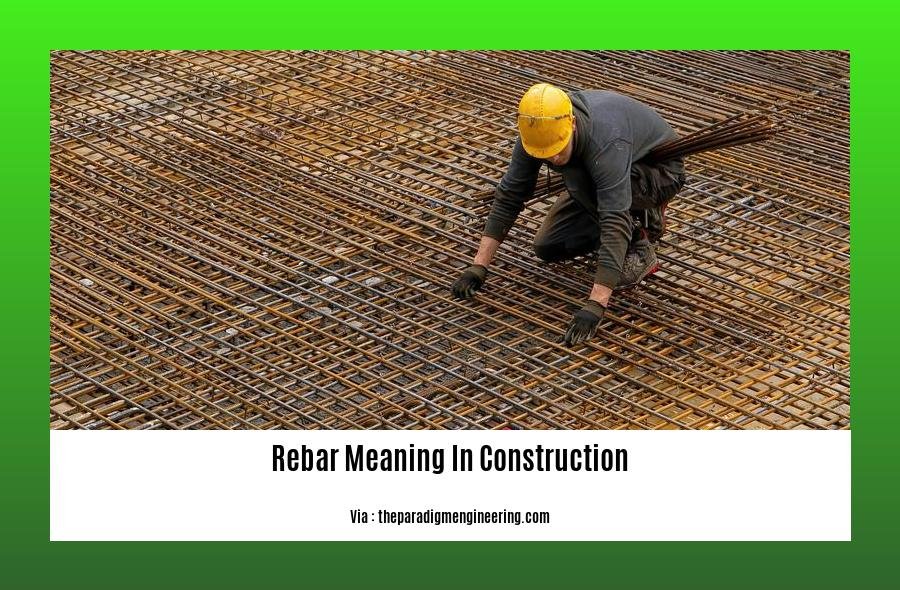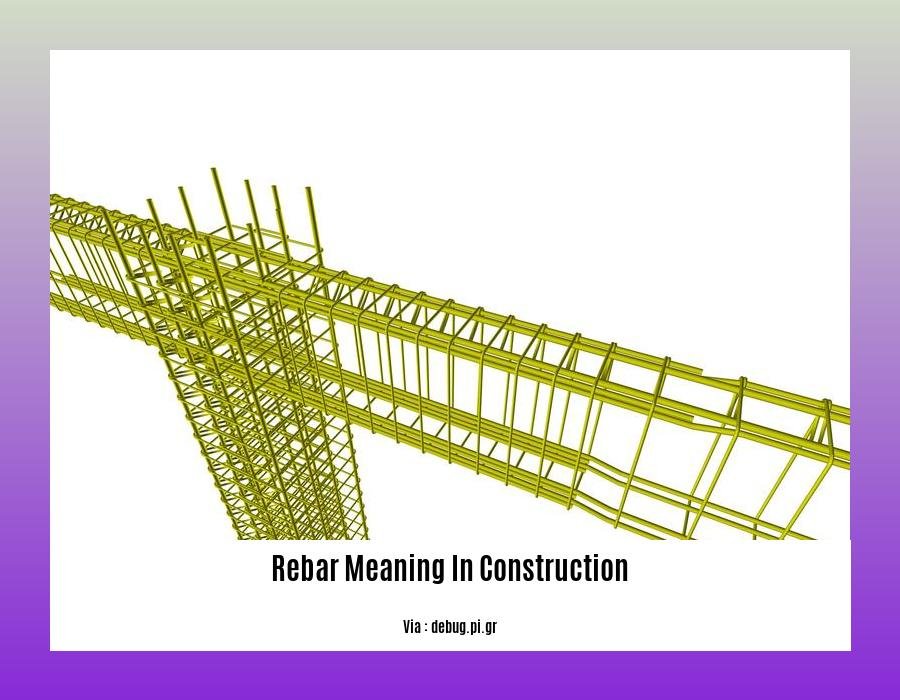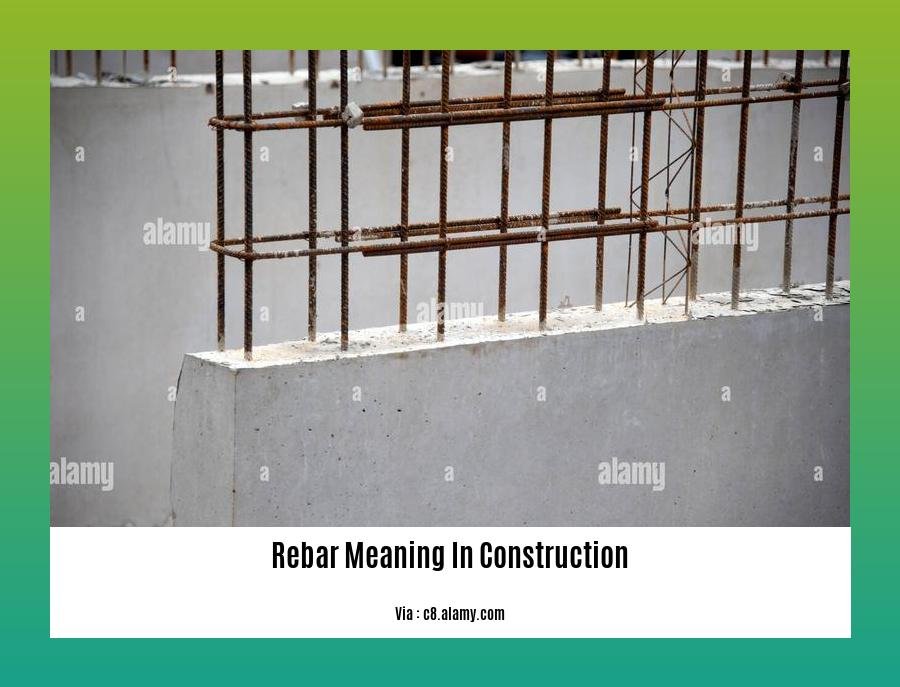Delving into the realm of construction, the term “rebar” emerges as a crucial element. [- What is Rebar Meaning in Construction?] In this article, we embark on a comprehensive exploration of rebar, its significance in structural reinforcement, and its diverse applications within the construction industry. Embarking on this journey, we unravel the intricate details of rebar, empowering you with a profound understanding of its role and importance in shaping the world around us.
Key Takeaways:
- Rebar (reinforcing steel bars) increases concrete’s strength and prevents cracking.
- Rebar is typically made of steel and is installed in concrete forms before pouring.
- It enhances concrete’s flexural strength, which is weak in tension.
- Rebar is used in various applications, such as floor slabs, walls, and posts.
- Common types of rebar include carbon steel, stainless steel, and epoxy-coated rebar.
- Rebar helps prevent concrete structures from failing or crumbling under tension.
- It adds structural strength and stability to concrete constructions.
Rebar Meaning in Construction

So, what exactly is rebar?
In construction, rebar, short for reinforcing steel bars, plays a starring role in strengthening your concrete structures, making them more resilient and less prone to cracking. Think of it as the backbone that gives your concrete the strength to withstand tension and compression.
Now, let’s talk about the types of rebar you’ll find on the construction site:
- Carbon steel rebar: The most popular choice, offering a balance of strength and affordability.
- Stainless steel rebar: Rust-resistant and perfect for projects where corrosion is a concern.
- Epoxy-coated rebar: Carbon steel rebar with an epoxy coating for enhanced corrosion protection.
How do you use rebar?
Rebar is typically used in concrete construction. It’s placed within concrete forms before the concrete is poured, forming a network of steel reinforcement that prevents cracking.
Why is rebar so important?
Rebar is essential for strengthening concrete structures because concrete is weak under tension. Rebar compensates for this weakness, providing the tensile strength needed to prevent the concrete from cracking or failing under stress.
Benefits of using rebar:
- Increased strength and stability
- Reduced cracking and improved durability
- Flexibility and adaptability to various project designs
Wrapping Up
So, now you have a better understanding of the rebar meaning in construction. It’s the backbone that gives concrete its strength, preventing it from crumbling or failing under tension. Next time you see those steel bars in your construction project, remember their crucial role in ensuring structural integrity.
If you’re embarking on a construction project and need to meticulously calculate the raw materials required, check out our raw material calculator for house construction to ensure seamless planning and budgeting.
For your RC construction endeavors, explore our RC construction equipment metal section to discover the latest machinery and solutions tailored to your project’s specific requirements.
If you’re looking for a reliable ready-mix concrete provider, head over to our ready-mix construction page to find reputable companies in your area.
Need a trusted partner for your ready-mix construction machinery? Visit our ready-mix construction machinery pvt ltd page to connect with industry-leading suppliers.
To delve into the advantages and applications of construction plants, dive into our comprehensive article on reasons for using construction plant, which provides valuable insights for optimizing your construction processes.
Uses of Rebar

Rebar is the invisible force that makes concrete structures like buildings and bridges strong and durable. It’s like the muscles in our body, giving concrete the strength it needs to resist cracking and collapse.
There are various uses of rebar in construction:
-
Reinforcing Concrete Slabs: Rebar forms a grid-like framework within concrete slabs, providing tensile strength to resist bending and cracking. It’s used in floors, driveways, and patios.
-
Strengthening Beams: In beams, rebar is placed along the bottom to counteract the downward force of gravity, preventing bending and failure. This is crucial in bridges and other load-bearing structures.
-
Enhancing Column Stability: Vertical rebar bars in columns resist compression and buckling, ensuring the column’s stability and load-bearing capacity in high-rise buildings and other tall structures.
-
Fortifying Walls: Rebar is used in retaining walls to resist soil pressure and prevent collapse. It provides tensile strength and ensures the wall’s structural integrity.
-
Reinforcing Foundations: Rebar is embedded in concrete foundations to resist the weight of the structure above and prevent cracking caused by soil movement and seismic activity.
Key Takeaways:
- Rebar is a crucial material that strengthens concrete by resisting tensile forces.
- It’s used in various construction applications, including slabs, beams, columns, walls, and foundations.
- Rebar improves structural stability, prevents cracking, and enhances the durability of concrete structures.
Relevant URL Sources:
- National Concrete Masonry Association: What is Rebar and Why Is It Used?
- The Concrete Network: Rebar: The Backbone of Concrete
Benefits of using rebar
When it comes to constructing buildings and other concrete structures, the strength and durability of the material used are paramount. Rebar plays an essential role in reinforcing concrete to enhance its performance and longevity. Here are some key Benefits of using rebar:
-
Increases structural strength: Rebar acts as a reinforcing element within concrete, providing tensile strength and preventing cracking under stress. It enhances the overall strength of the structure, enabling it to withstand various loads and external forces.
-
Enhances durability and longevity: Rebar helps protect concrete from deterioration caused by weathering, corrosion, and environmental factors. It prevents the formation of cracks that can weaken the structure over time, thus extending its lifespan.
-
Reduces cracking: Rebar’s high tensile strength helps control cracking and shrinkage in concrete. By resisting tension and distributing stresses, it maintains the structural integrity of the concrete and prevents premature failure.
-
Improves seismic resistance: In areas prone to earthquakes, rebar is crucial for reinforcing concrete structures. Its ability to absorb and disperse energy during seismic events enhances the structure’s stability and resistance to collapse.
-
Cost-effective: Reinforcing concrete with rebar is a cost-effective solution compared to using other materials or techniques to achieve similar strength and durability. It helps optimize construction costs while ensuring the longevity of the structure.
Key Takeaways:
- Rebar increases the structural strength of concrete, enabling it to withstand various loads and forces.
- It enhances the durability and longevity of concrete by preventing deterioration and cracking.
- Rebar reduces cracking and shrinkage in concrete, maintaining its structural integrity.
- It improves seismic resistance, making structures more resilient to earthquakes.
- Reinforcing concrete with rebar is a cost-effective solution, optimizing construction costs while ensuring structural stability.
Relevant URL Sources:
Considerations for using rebar
In construction, rebar plays a crucial role in enhancing the strength and durability of concrete structures. Consider these factors when using rebar:
-
Type of rebar: Choose the appropriate rebar grade based on the specific requirements of the project. Consider factors such as tensile strength, corrosion resistance, and weldability.
-
Size and spacing: Determine the optimal rebar size and spacing to achieve the desired level of reinforcement. Consider the loads the structure will bear and the concrete cover requirements.
-
Placement: Position the rebar accurately within the concrete formwork to ensure proper load transfer and prevent structural weaknesses. Use spacers and chairs to maintain the specified concrete cover.
-
Overlapping and splicing: When rebar lengths are insufficient, overlap or splice them to maintain continuity. Follow recommended guidelines for overlap lengths and splicing methods to ensure adequate strength and avoid potential failure points.
-
Corrosion protection: In areas exposed to moisture or corrosive environments, consider using epoxy-coated or stainless steel rebar to enhance durability and prevent corrosion.
-
Cost-effectiveness: Evaluate the cost implications of different rebar options and installation methods. Consider factors such as material costs, labor costs, and long-term maintenance expenses.
Key Takeaways:
- Rebar is essential for reinforcing concrete structures and enhancing their tensile strength.
- Proper selection, placement, and installation of rebar are crucial for structural integrity.
- Factors to consider include rebar type, size, spacing, placement, overlapping, splicing, corrosion protection, and cost-effectiveness.
Relevant URL Sources:
FAQs on “Additional Information You Can Bras Construction/re-adding-create-new-to-do-not-foundational
1
- How to Remove Water Stains from Fabric: A Complete Guide - April 26, 2025
- How to Get Motor Oil Out of Clothes: Proven Methods & Expert Tips - April 26, 2025
- How to Get Deodorant Out of Black Shirts: Easy Stain Removal Guide - April 26, 2025










